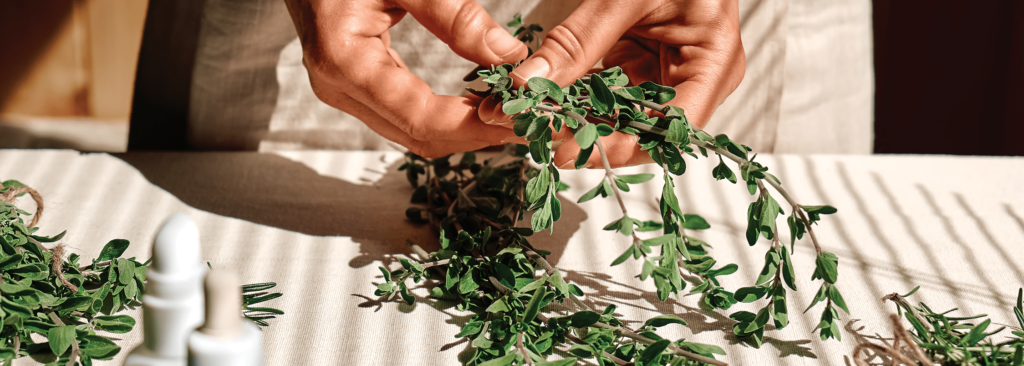ENLIVEN YOUR KITCHEN AND PALATE WITH HERBS
WRITTEN BY VICTORIA HITTNER
“Herbs are the friend of the physician and the pride of cooks.” It’s a quote attributed to Charlemagne the Great, but the sentiment rings true centuries later. Whether blooming in a garden or simmering in a pot, herbs are an enticing delight for the senses. And while North American kitchen staples like rosemary, basil, and thyme are culinary stalwarts for a reason, there’s an entire world of herbs to explore. Try these less-common delights the next time you plant your garden or reach for a new recipe.

Culinary Use.
While most herbs offer more than just flavor, these standouts truly shine in the kitchen.
Chervil (Anthriscus cerefolium)
A key component of the classic French fines herbes mix, chervil offers a delicate taste and aroma of licorice. The root can be eaten as a vegetable, but its fresh leaves are most versatile. Use it in milder dishes with fish or poultry to maximize its flavor.
Lemon verbena (Aloysia citriodora or Lippia citriodora)
Fragrant and flavorful, lemon verbena adds a touch of citrus to your garden, meats, syrups, or beverages. Use it in place of lemon zest for a lighter flavor in seafood or poultry dishes or enhance your favorite teas, lemonades, and even ice creams with its sweet tang.
Nasturtium (Tropaeolum majus)
Cultivated for its vibrant blooms and greenery, nasturtiums may be growing in your garden already. The stems, leaves, and flowers are all edible, and its blooms make a brilliant garnish. Crush its leaves for a peppery pesto or chop its stems in place of chives. (Tip: Scatter them throughout your garden for easy groundcover, pollination, and as a natural pest repellant. Check with your local nursery to confirm it’s not invasive in your area.)
Vietnamese coriander (Persicaria odorata)
An easier-to-grow alternative to cilantro (and sometimes peppermint), Vietnamese coriander is a popular herb in its native southeast Asia. Its pungent, smoky attributes pack a punch in soups, stews, and wraps.
Dual Purpose.
Plant these herbs in your home garden for additional medicinal or multipurpose benefits. Note that these medicinal uses stem from traditional home remedies. Always consult your healthcare provider.
Catnip (Nepeta cataria)
Useful for more than your feline friends, catnip acts as a natural insecticide when planted among rows in your garden. Its dried leaves can also be steeped into a tea for relieving stress and digestive discomforts.
Feverfew (Tanacetum parthenium)
Traditionally used to treat headaches, fevers, and colds, feverfew has been referred to as “medieval aspirin.”
Lovage (Levisticum officinale)
A member of the parsley family, lovage is a workhorse among herbs. The entire plant is edible and tastes like sweet celery. It’s long been a favorite in salads and soups and historically was used for its anti-inflammatory properties. Remember Charlemagne? He prized lovage so much he ordered it be grown in every imperial garden.
Stevia (Stevia rebaudiana)
Stevia leaves have been used in its native Paraguay for generations, but its global popularity has exploded in recent years. Create your own sugar alternative at home using its fresh or dried leaves. (Tip: You can grow stevia plants in-ground or within containers, but keep in mind they like plenty of space.)
New Varieties, Old Favorites.
Still beholden to your standbys? You don’t have to try a completely new herb to find new flavors. Experiment with some of these varieties for a fresh take on your garden favorites.
Chocolate mint (Mentha × piperita f. citrata)
As its name suggests, this mint variety adds a dash of unexpected sweetness to both hot and cold drinks. Muddle it or use as a fragrant garnish. During the warmer months of the year, sneak in a few sprigs when making homemade ice cream for the tastiest mint-chocolate confection.
Pineapple sage (Salvia elegans)
Elevate any dish you’d normally make with sage using this sunny variety. With a distinctly tropical flavor, pineapple sage pairs well with pork and other lighter proteins. Traditional medicinal practices suggest brewing the leaves as a tea for their calming and digestive properties.
Thai basil (Ocimum basilicum variant thyrsiflora)
A key ingredient in Thai curries, this variant adds a touch of spiciness to the classic, sweet-and-savory taste of Italian basil. Another bonus? It holds up better during the cooking process, infusing your dishes with a strong flavor.



